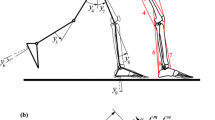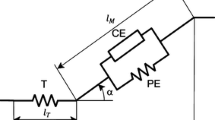Abstract
Determining the muscle forces that underlie some experimentally observed human motion, is a challenging biomechanical problem, both from an experimental and a computational point of view. No non-invasive method is currently available for experimentally measuring muscle forces. The alternative of computing them from the observed motion is complicated by the inherent overactuation of the human body: it has many more muscles than strictly needed for driving all the degrees of freedom of the skeleton. As a result, the skeleton’s equations of motion do not suffice to determine the muscle forces unambiguously. Therefore, muscle force determination is often reformulated as a (large-scale) optimization problem.
Generally, the optimization approaches are classified according to the formalism, inverse or forward, adopted for solving the skeleton’s equations of motion. Classical inverse approaches are fast but do not take into account the constraints imposed by muscle physiology. Classical forward approaches, on the other hand, do take the muscle physiology into account but are extremely costly from a computational point of view.
The present paper makes a double contribution. First, it proposes a novel inverse approach that results from including muscle physiology (both activation and contraction dynamics) in the inverse dynamic formalism. Second, the efficiency with which the corresponding optimization problem is solved is increased by using convex optimization techniques. That is, an approximate convex program is formulated and solved in order to provide a hot-start for the exact nonconvex program. The key element in this approximation is a (global) linearization of muscle physiology based on techniques from experimental system identification. This approach is applied to the study of muscle forces during gait. Although the results for gait are promising, experimental study of faster motions is needed to demonstrate the full power and advantages of the proposed methodology, and therefore is the subject of subsequent research.
Similar content being viewed by others
Abbreviations
- a j :
-
Activation of muscle j, [–]
- α j :
-
Pennation angle of muscle j, [°]
- f s :
-
Sample frequency of the simulation, [Hz]
- F mt,j :
-
Musculotendon force of muscle j, [N]
- j :
-
Index indicating the muscles of the musculoskeletal model; j={1,…,J}, [–]
- J :
-
Total number of muscles included in the musculoskeletal model, [–]
- k :
-
Index indicating the time instants of the simulation; k={1,…,K}, [–]
- K :
-
Total number of time instants of the simulation, [–]
- l m,j :
-
Muscle fiber length of muscle j, [m]
- l mt,j :
-
Musculotendon length of muscle j, [m]
- l t,j :
-
Tendon length of muscle j, [m]
- n :
-
Index indicating the degrees of freedom of the musculoskeletal model; n={1,…,N}, [–]
- N :
-
Total number of degrees of freedom of the musculoskeletal model, [–]
- T s :
-
Sample period of the simulation, [s]
- τ act,j :
-
Activation time constant of muscle j, [s]
- τ deact,j :
-
Deactivation time constant of muscle j, [s]
- u j :
-
Excitation of muscle j, [–]
- v m,j :
-
Muscle fibre lengthening speed of muscle j, [m/s]
- \(\mathbf{c}(\mathbf{q},\mathbf{\dot{q}})\) :
-
∈ℝN, vector of generalized coriolis and centrifugal forces, [N, N m]
- F mt :
-
∈ℝJ, vector of the musculotendon forces, [N]
- g(q):
-
∈ℝN, vector of generalized gravitational forces, [N, N m]
- M(q):
-
∈ℝN×N, generalized inertia matrix, [kg, kg m2]
- q :
-
∈ℝN, vector of generalized coordinates of the skeleton, [m, rad]
- R(q):
-
∈ℝN×J, geometric transformation matrix of F mt to generalized joint forces, [m, –]
- S(q):
-
∈ℝN×12, geometric transformation matrix of W ext to generalized joint forces, [m, –]
- T ext(q,W ext):
-
∈ℝN, vector of generalized joint forces delivered by the generalized external forces, [N, N m]
- T mt(q,F mt):
-
∈ℝN, vector of generalized joint forces delivered by the musculotendon forces, [N, N m]
- \(\mathbf{T}_{\mathrm{pass}}(\mathbf{q},\mathbf{\dot{q}})\) :
-
∈ℝN, vector of generalized passive forces, [N, N m]
- W ext :
-
∈ℝ12, vector of generalized external forces acting on the skeleton, [N, N m]
References
An KN, Kaufman KR, Chao EY (1989) Physiological considerations of muscle force through the elbow joint. J Biomech 22(11–12):1249–1256
Anderson FC (1999) A dynamic optimization solution for a complete cycle of normal gait. PhD thesis, University of Texas
Anderson FC, Pandy MG (2001) Dynamic optimization of human walking. J Biomech Eng 123(5):381–390
Arnold AS, Salinas S, Asakawa DJ, Delp SL (2000) Accuracy of muscle moment arms estimated from MRI-based musculoskeletal models of the lower extremity. Comput Aided Surg 5(2):108–119
Bergmann G, Deuretzbacher G, Heller M, Graichen F, Rohlmann A, Strauss J, Duda GN (2001) Hip contact forces and gait patterns from routine activities. J Biomech 34(7):859–871
Boyd S, Vandenberghe L (2004) Convex optimization. Cambridge University Press, Cambridge
Brand RA, Pedersen DR, Friederich JA (1986) The sensitivity of muscle force predictions to changes in physiologic cross-sectional area. J Biomech 19(8):589–596
Brand RA, Pedersen DR, Davy DT, Kotzar GM, Heiple KG, Goldberg VM (1994) Comparison of hip force calculations and measurements in the same patient. J Arthroplast 9(1):45–51
Cappozzo A, Cantani F, Leardini A, Benedetti MG, Croce UD (1996) Position and orientation in space of bones during movement: experimental artefacts. Clin Biomech 11(2):90–100
Chenut X, Fisette P, Samin J-C (2002) Recursive formalism with a minimal dynamic parametrization for the identification and simulation of multibody systems: application to the human body. Multibody Syst Dyn 8(2):117–140
Chow CK, Jacobson DH (1971) Studies of human locomotion via optimal programming. Math Biosci 10:239–306
Craig JJ (1986) Introduction to robotics: mechanics and control. Addison–Wesley, Reading
Crowninshield RD, Brand RA (1981) A physiologically based criterion of muscle force prediction in locomotion. J Biomech 14(11):793–801
Crowninshield RD, Johnston RC, Andrews JG, Brand RA (1978) A biomechanical investigation of the human hip. J Biomech 11(1–2):75–85
Dai TH, Liu JZ, Saghal V, Brown RW, Yue GH (2001) Relationship between muscle output and functional MRI-measured brain activation. Exp Brain Res 140(3):290–300
Davy DT, Audu ML (1987) A dynamic optimization technique for predicting muscle forces in the swing phase of gait. J Biomech 20(2):187–201
de Leva P (1996) Adjustments to Zatsiorsky-Seluyanov’s segment inertia parameters. J Biomech 29(9):1223–1230
Delp SL, Loan JP, Hoy MG, Zajac FE, Topp EL, Rosen JM (1990) An interactive graphics based model of the lower extremity to study orthopaedic surgical procedures. IEEE Trans Biomed Eng 37(8):757–767
Drace JE, Pelc NJ (1994) Skeletal muscle contraction: analysis with use of velocity distributions from phase-contrast MR imaging. Radiology 193(2):423–429
Dul J, Johnson GE, Shiavi R, Townsend MA (1984) Muscular synergism 2: a minimum-fatigue criterion for load sharing between synergistic muscles. J Biomech 17(9):675–684
Ebashi S, Endo M (1968) Calcium ion and muscular contraction. Prog Biophys Mol Biol 18:123–183
Gage JR (1991) Gait analysis in cerebral palsy. Mac Keith Press
Gill PE, Murray W, Saunders MA (2002) User’s guide for SNOPT version 6, a Fortran package for large-scale nonlinear programming
Graham GC, Sin KS (1984) Adaptive filtering, prediction and control. Prentice Hall, New York
Hatze H (1976) The complete optimization of a human motion. Math Biosci 28:99–135
Hatze H (1981) A comprehensive model for human motion simulation and its application to the take-off phase of the long jump. J Biomech 14(3):135–142
Haug EJ (1989) Computer aided kinematics and dynamics of mechanical systems. Basic methods, vol. I. Allyn and Bacon
He JP, Levine WS, Loeb GE (1991) Feedback gains for correcting small perturbations to standing posture. IEEE Trans Autom Control 36(3):322–332
Heller MO, Bergmann G, Deuretzbacher G, Durselen L, Pohl M, Claes L, Haas NP, Duda GN (2001) Musculo-skeletal loading conditions at the hip during walking and stair climbing. J Biomech 34(7):883–893
Hermens HJ, Freriks B, Disselhorst-Klug C, Rau G (2000) Development of recommendations for SEMG sensors and sensor placement procedures. J Electromyogr Kinesiol 10(5):361–374
Kleeman RU, Heller MO, Stoeckle U, Taylor WR, Duda GN (2003) THA loading arising from increased femoral anteversion and offset may lead to critical cement stresses. J Orthop Res 21(5):767–774
Larsen B, Mrachacz-Kersting N, Lavoie BA, Voigt M (2006) The amplitude modulation of the Quadriceps H-reflex in relation to the knee joint action during walking. Exp Brain Res 170(4):555–566
Lieber RL (1992) Skeletal muscle structure and function: implications for rehabilitation and sports medicine. Williams & Wilkins, Baltimore
Liu MM, Herzog W, Savelberg H (1999) Dynamic muscle force predictions from EMG: an artificial neural network approach. J Electromyogr Kinesiol 9(6):391–400
Ljung L (1999) System identification—theory for the user. PTR Prentice Hall, New York
Maganaris CN, Baltzopoulos V, Tsaopoulos D (2006) Muscle fibre length-to-moment arm ratios in the human lower limb determined in vivo. J Biomech 39(9):1663–1668
Murtagh BA, Saunders MA (1998) MINOS 5.5 user’s guide
Nene A, Mayagoitia R, Veltink P (1999) Assessment of rectus femoris function during initial swing phase. Gait Posture 9(1):1–9
Pandy MG, Anderson FC, Hull DG (1992) A parameter optimization approach for the optimal control of large-scale musculoskeletal systems. J Biomech Eng 114(4):450–460
Pandy MG, Garner BA, Anderson FC (1995) Optimal control of non-ballistic muscular movements: a constraint-based performance criterion for rising from a chair. J Biomech Eng 117(1):15–26
Patriarco AG, Mann RW, Simon SR, Mansour JM (1981) An evaluation of the approaches of optimization models in the prediction of muscle forces during human gait. J Biomech 14(8):513–525
Pedotti A, Krishnan VV, Stark L (1978) Optimization of muscle-force sequencing in human locomotion. Math Biosci 38(1–2):57–76
Perry J (1992) Gait analysis: normal and pathological function. SLACK Incorporated
Pintelon R, Schoukens J (2001) System identification: a frequency domain approach. Wiley–IEEE Press, New York
Raasch CC, Zajac FE, Ma B, Levine WS (1997) Muscle coordination of maximum-speed pedaling. J Biomech 30(6):595–602
Raikova RT, Prilutsky BI (2001) Sensitivity of predicted muscle forces to parameters of the optimization-based human leg model revealed by analytical and numerical analyses. J Biomech 34(10):1243–1255
Seireg A, Arvikar RJ (1975) Prediction of muscular load sharing and joint forces in the lower extremities during walking. J Biomech 8(2):89–102
Spoor CW, van Leeuwen JL (1992) Knee muscle moment arms from MRI and from tendon travel. J Biomech 25(2):201–206
Stansfield BW, Nicol AC, Paul JP, Kelly IG, Graichen F, Bergmann G (2003) Direct comparison of calculated hip joint contact forces with those measured using instrumented implants: an evaluation of a three-dimensional mathematical model of the lower limb. J Biomech 36(7):929–936
Umberger BR, Gerritsen KG, Martin PE (2003) A model of human muscle energy expenditure. Comput Methods Biomech Biomed Eng 6(2):99–111
Winters JM, Stark L (1988) Estimated mechanical properties of synergistic muscle involved in movements of a variety of human joints. J Biomech 21(12):1027–1041
Yamaguchi GT (2001) Dynamic modelling of musculoskeletal motion—a vectorized approach for biomechanical analysis in three dimensions. Kluwer Academic, Dordrecht
Yamaguchi GT, Zajac FE (1990) Restoring unassisted natural gait to paraplegics via functional neuromuscular stimulation: a computer simulation study. IEEE Trans Biomed Eng 37(9):886–902
Yamaguchi GT, Moran DW, Si J (1995) A computationally efficient method for solving the redundant problem in biomechanics. J Biomech 28(8):999–1005
Zajac FE (1989) Muscle and tendon: properties, models, scaling and application to biomechanics and motor control. Crit Rev Biomed Eng 17(4):359–411
Author information
Authors and Affiliations
Corresponding author
Rights and permissions
About this article
Cite this article
Pipeleers, G., Demeulenaere, B., Jonkers, I. et al. Dynamic simulation of human motion: numerically efficient inclusion of muscle physiology by convex optimization. Optim Eng 9, 213–238 (2008). https://doi.org/10.1007/s11081-007-9010-6
Received:
Revised:
Published:
Issue Date:
DOI: https://doi.org/10.1007/s11081-007-9010-6




